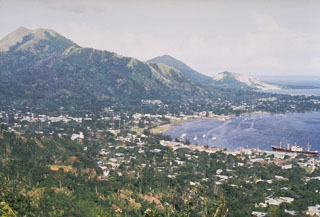Report on Rabaul (Papua New Guinea) — 23 January-29 January 2013
Smithsonian Institution / US Geological Survey
Weekly Volcanic Activity Report, 23 January-29 January 2013
Managing Editor: Sally Sennert.
Please cite this report as:
Global Volcanism Program, 2013. Report on Rabaul (Papua New Guinea) (Sennert, S, ed.). Weekly Volcanic Activity Report, 23 January-29 January 2013. Smithsonian Institution and US Geological Survey.
Rabaul
Papua New Guinea
4.2459°S, 152.1937°E; summit elev. 688 m
All times are local (unless otherwise noted)
RVO reported that during 23-24 January variable emissions at Rabaul mostly consisted of white vapor plumes, although following explosions gray plumes rose 600 m above the crater. Some roaring and rumbling noises were noted. Five explosions were detected between 0656 and 0859 on 24 January; these explosions produced light gray ash plumes that rose as high as 1 km above sea level. After the explosion at 0656 white plumes also rose from the crater. All plumes drifted E and ESE. Several explosions were detected between 1630 on 24 January and 0232 on 25 January, although seismicity remained at a low level. White vapor plumes and occasional light gray ash plumes rose from the crater and drifted E and SE.
About five explosions occurred between 1947 on 26 January and 0414 on 27 January, producing plumes that drifted ESE. An explosion at 1000 on 27 January produced a dense, billowing, light gray ash plume that rose a few hundred meters above sea level and drifted ESE. Ash emissions continued until 1500, followed by white vapor emissions. Six explosions were detected overnight, possibly generating ash plumes that drifted E and ESE.
During the morning of 28 January white vapor plumes rose from the crater. At 1003 an explosion produced a dense, billowing, gray ash plume; ash emissions continued from the next hour and then turned to white vapor. Two explosions occurred at 1323 and 1816, generating ash plumes and sub-continuous emissions for one hour and 15-20 minutes, respectively. Plumes again drifted E and ESE. White plumes rose from the crater afterwards through 29 January, but an explosion at 1723 generated a dense, billowing ash plume followed by a short period of sub-continuous emissions.
Geological Summary. The low-lying Rabaul caldera on the tip of the Gazelle Peninsula at the NE end of New Britain forms a broad sheltered harbor utilized by what was the island's largest city prior to a major eruption in 1994. The outer flanks of the asymmetrical shield volcano are formed by thick pyroclastic-flow deposits. The 8 x 14 km caldera is widely breached on the east, where its floor is flooded by Blanche Bay and was formed about 1,400 years ago. An earlier caldera-forming eruption about 7,100 years ago is thought to have originated from Tavui caldera, offshore to the north. Three small stratovolcanoes lie outside the N and NE caldera rims. Post-caldera eruptions built basaltic-to-dacitic pyroclastic cones on the caldera floor near the NE and W caldera walls. Several of these, including Vulcan cone, which was formed during a large eruption in 1878, have produced major explosive activity during historical time. A powerful explosive eruption in 1994 occurred simultaneously from Vulcan and Tavurvur volcanoes and forced the temporary abandonment of Rabaul city.
Source: Rabaul Volcano Observatory (RVO)

